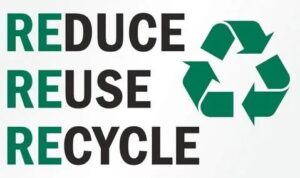Reduce, Reuse and Recycle
- Reduce – means to minimise the amount of waste we create.

- Reuse – refers to using items more than once instead of throwing them away.
- Recycle – means using old products in new ways.
This is our planet and on our planet is our country, the place where we live, where our family and friends live we should respect our planet and our country and help it to survive and grow for all of us for now and into the future.
Did you know?
- Australians are the second highest producers of waste per person, in the world, after the USA.
- Each of us sends around 690 kilograms of waste to landfill every year.
- By recycling one aluminium can, you can save enough energy to run a television for three hours.
- Around 3.5 million tonnes of paper and cardboard are used in Australia each year – enough to fill 160,000 large semi-trailers.
- Reducing and reusing materials saves resources and purchase costs.
- Recycling reduces the amount of waste we send to landfill, both at home and at the office. Paper, cardboard, bottles, cans, computers and equipment such as printer cartridges and office supplies can all be recycled to help reduce our impact on the environment.
Recycle and Reuse Actions
- Supply crockery and steel cutlery, and remove all disposable kitchen items.
- Promote the use of reusable mugs for local takeaway coffee.
- Order 10 per less food from caterers than the number of people attending to avoid excessive food wastage.
- Recycle all paper from your shredder to donate to schools or pet shops for reuse.
- Involve your cleaners or waste management providers in designing a recycling system that works.
- Add recycling bins to your existing rubbish bin locations to increase the accessibility of recycling infrastructure.
- Install an organic bin to recycle food and green waste. Get a worm farm or organise an organics collection service.
- Remove landfill bins from individual desks and replace them with paper recycling bins. Train staff to use the one-bin system and walk to put rubbish in landfill bins.
- Talk to your waste contractor to find out what services they offer, for ideas and help with your workplace’s recycling and waste disposal systems, and advice on what materials can be recycled.
- Introduce recycling collection points for infrequent items such as printer cartridges, CDs, mobile phones, corks, batteries and fluorescent tubes.
Spread the Word
- Keep your message simple and communicate regularly. Be creative and make sure your message gets through.
- Inform people of the environmental benefits of recycling through regular emails and staff communications.
- Involve your cleaners so that they too can communicate the message and assist in getting the system right.
- Keep staff informed of your organisation’s progress against set targets and how staff are contributing to meet the targets.
- Email the people in your office a list of recycling initiatives you have implemented in your workplace.
- Place posters around the workplace instructing staff where to find central recycling stations and collection points.
- Label your rubbish and recycling bins clearly and with colour-coded signs so everyone can see easily, and quickly which products go in which bins.
- Create an A-Z list of items commonly disposed of and which bin each item should be placed in. Place the sign in common areas such as staff tea rooms and photocopy rooms.
Keep the Message Fresh
- Reinforce messages regularly. Use prompts and reminders to keep resource-smart actions top of mind.
- Place labelled recycling bins at the paper shredder to remind people to recycle.
- Put clear, instructional labels on bins so people know if they are for regular rubbish or recyclable items.
- Place recycling bins near where the waste is created. For example, place paper recycling bins next to the printer and photocopiers.
- Put up signs reminding people which objects go in each bin.
- Design a reduce, reuse and recycle message for your workplace. Reward and recognise People are more likely to do something if there’s something in it for them. Positive reinforcement is a great way to gain support for a new initiative.
- Put a small reward on the desks of people who regularly recycle or compost their rubbish.
- Set a recycling target and have a staff lunch or morning tea to celebrate when you reach it.
- Hold a ‘waste wise’ lunch to demonstrate a low packaging lunch and good recycling practices.
- Keep track of success
- Evaluate your initiatives to see what is working, what isn’t and where you can improve. Set a time frame for targets, such as 6 or 12 months and stick to it.
- Conduct a monthly survey to see how many people use the recycling bins and whether they prioritize reducing and reusing.
- Use the survey to determine how well they understand your educational materials and posters.
- Measure the total waste produced (waste sent to landfill plus materials recycled) and map over time. Set a target to reduce your total waste production and reduce consumption.
- Measure your percentage diversion rate (the percentage of the total waste produced that is sent for recycling instead of landfill). Aim to increase your percentage diversion.
Useful Links to Reduce, Reuse, Recycle
- Clean up Australia cleanup.org.au
- Visy Recycling visy.com.au/recycling


Pingback: Explore the Benefits at Shopping at Biome Eco Store